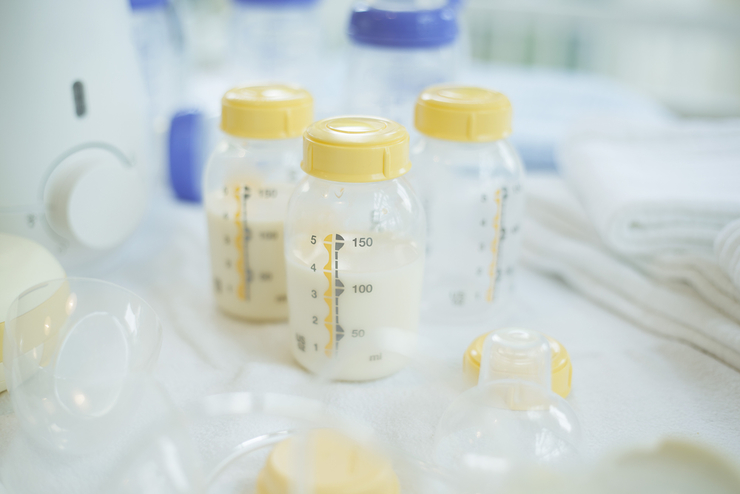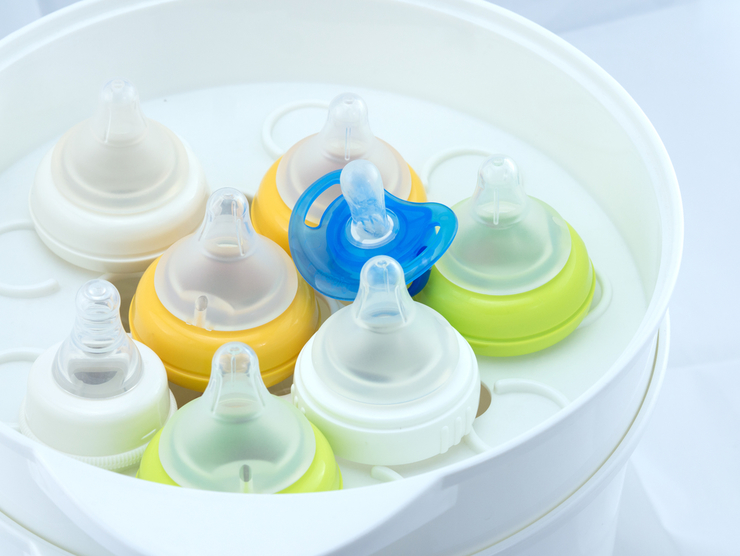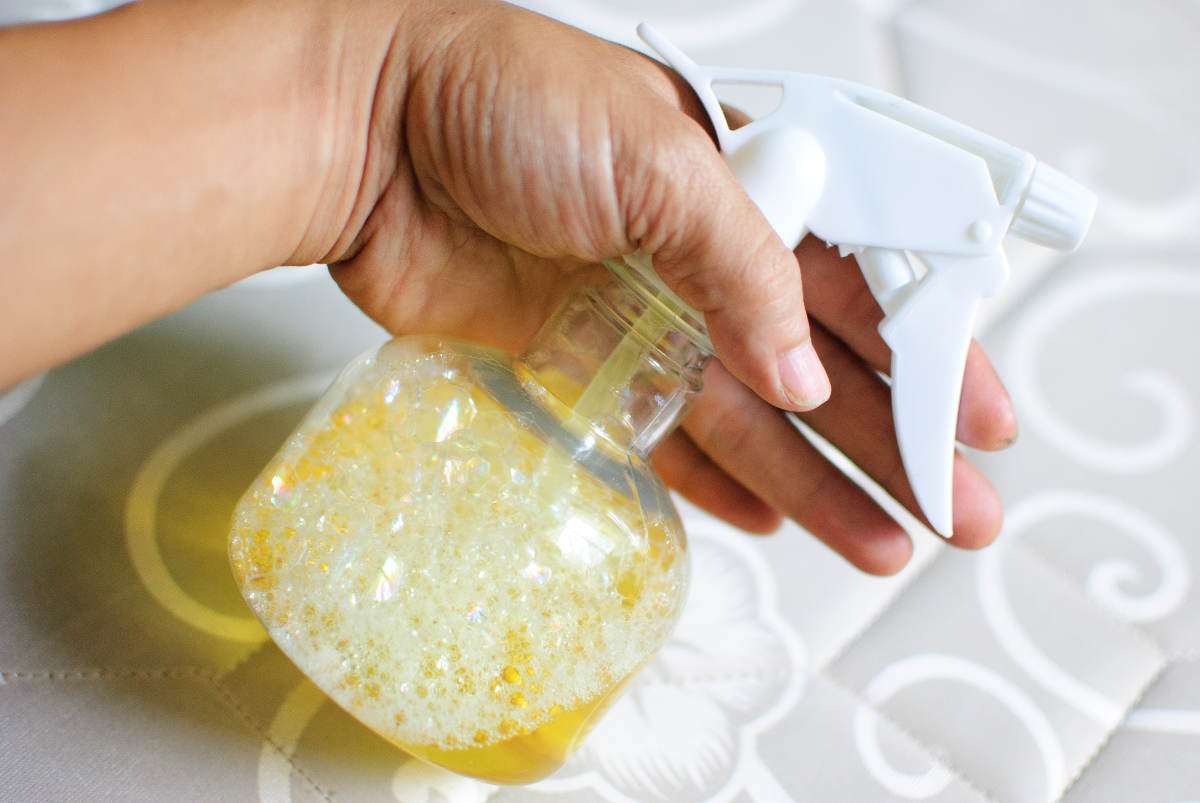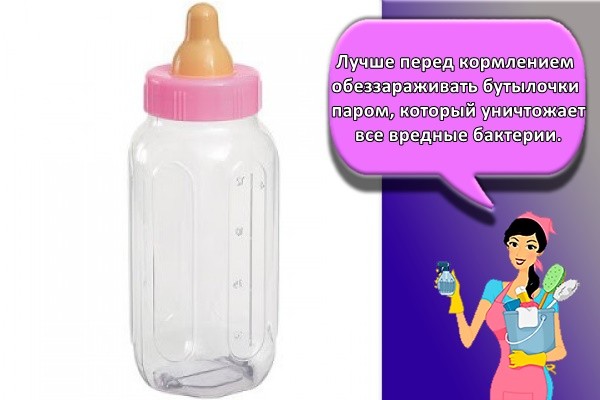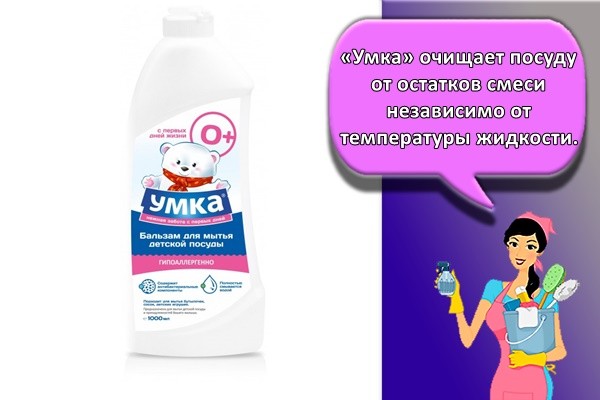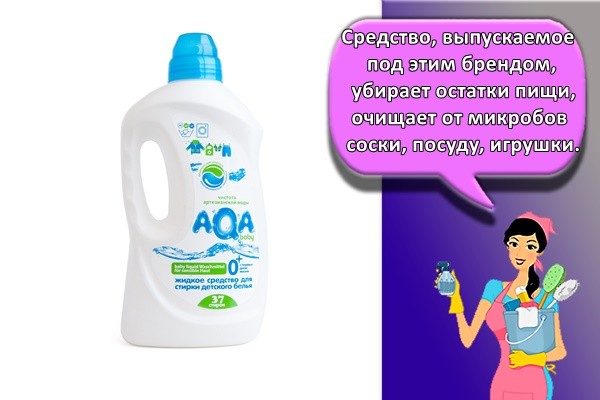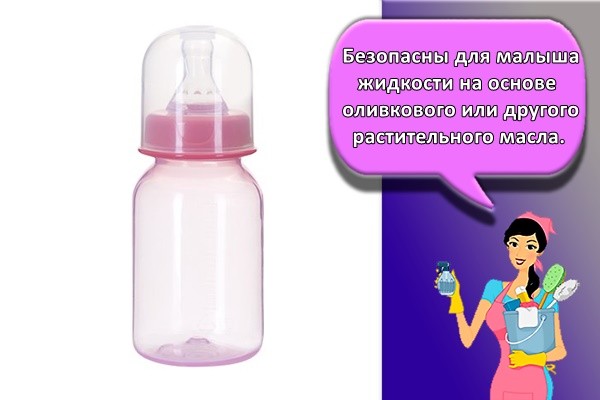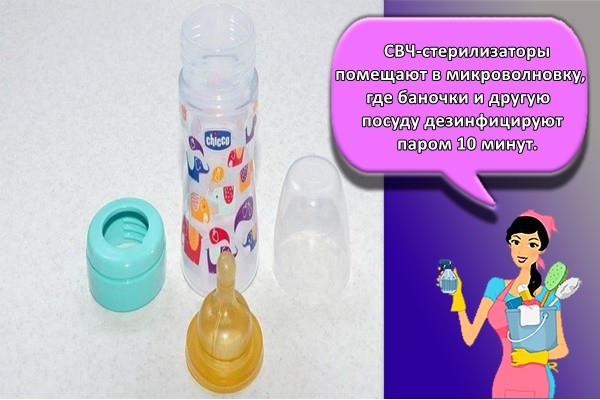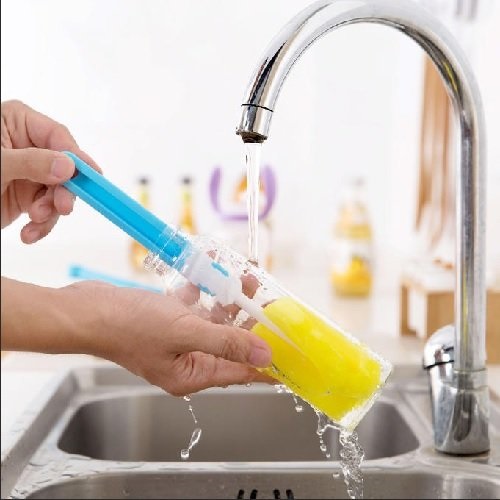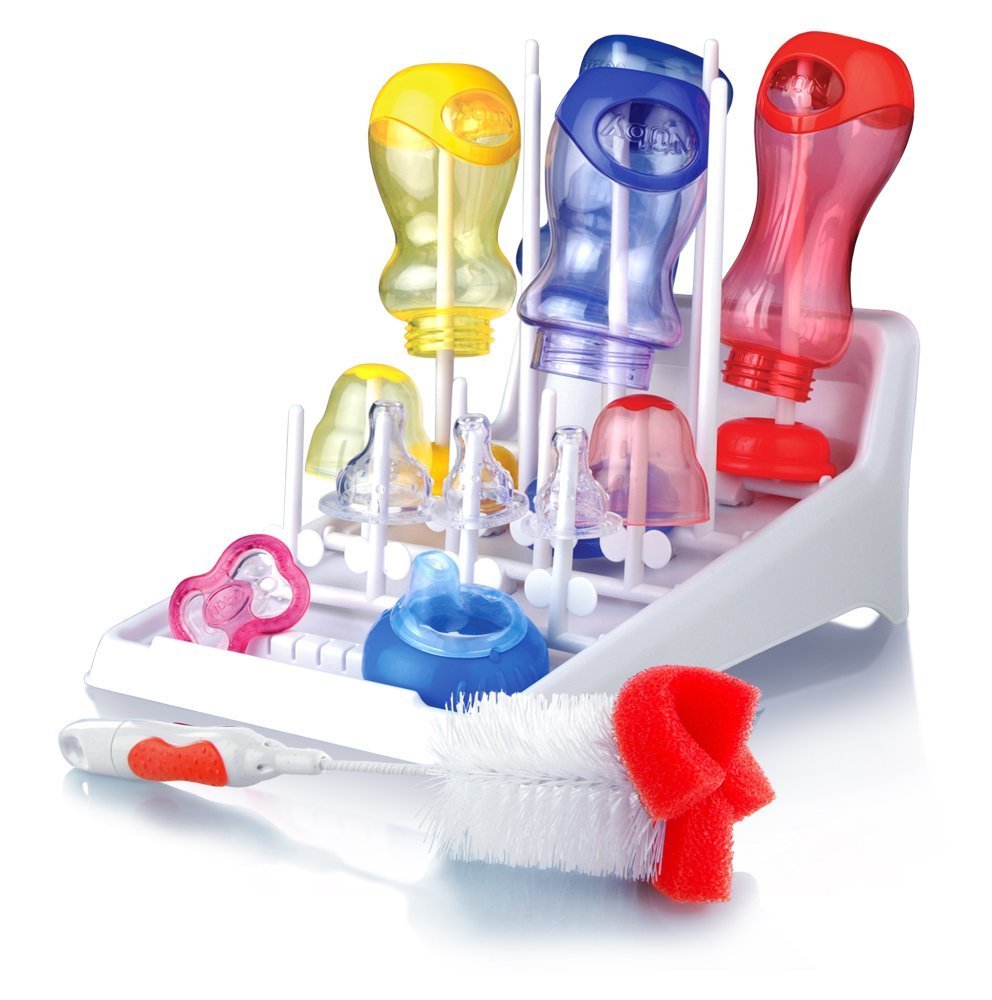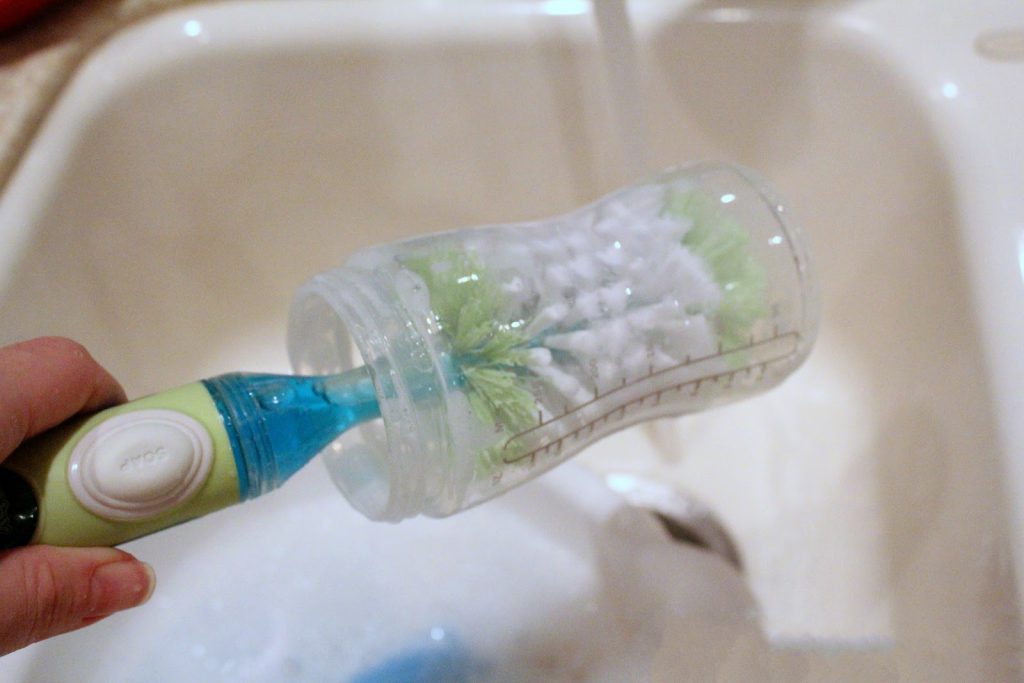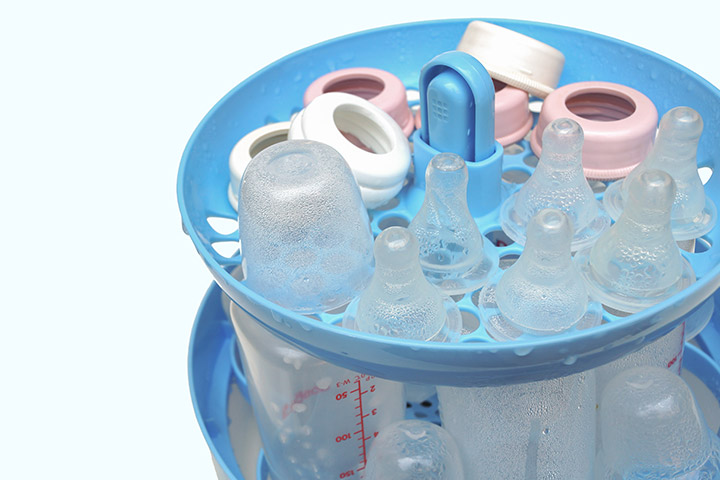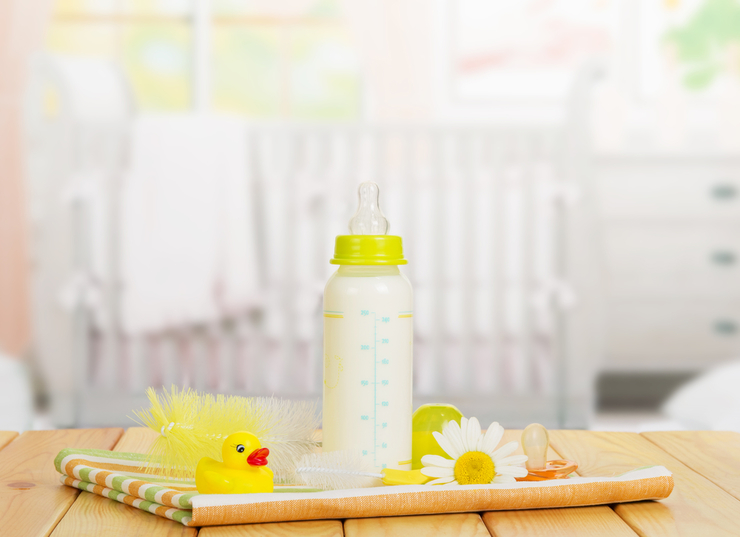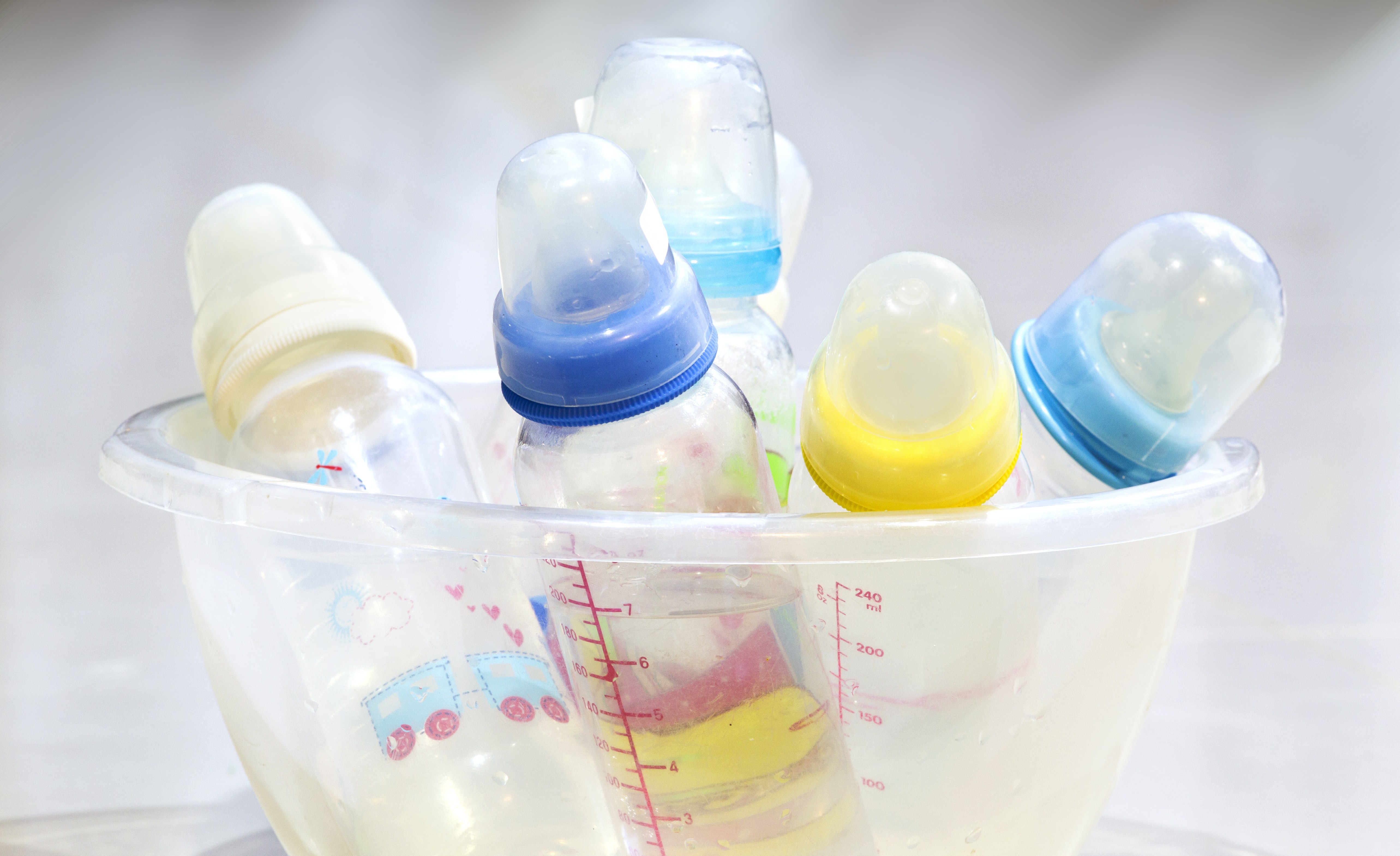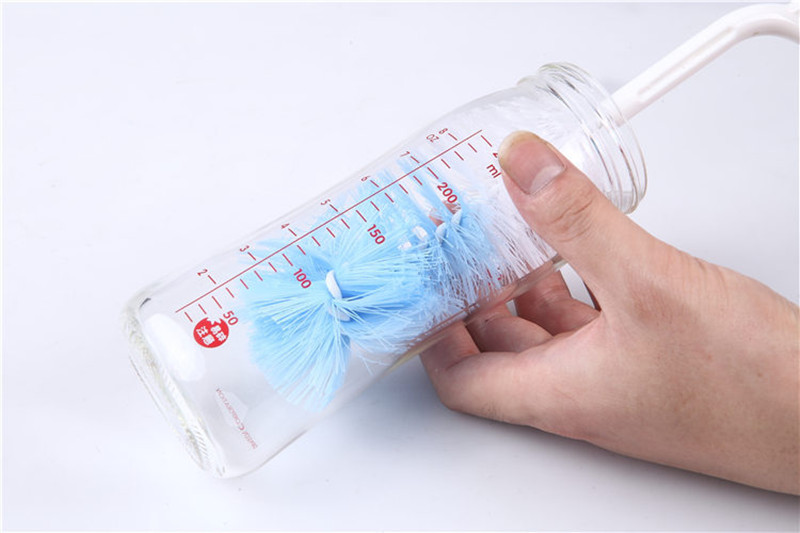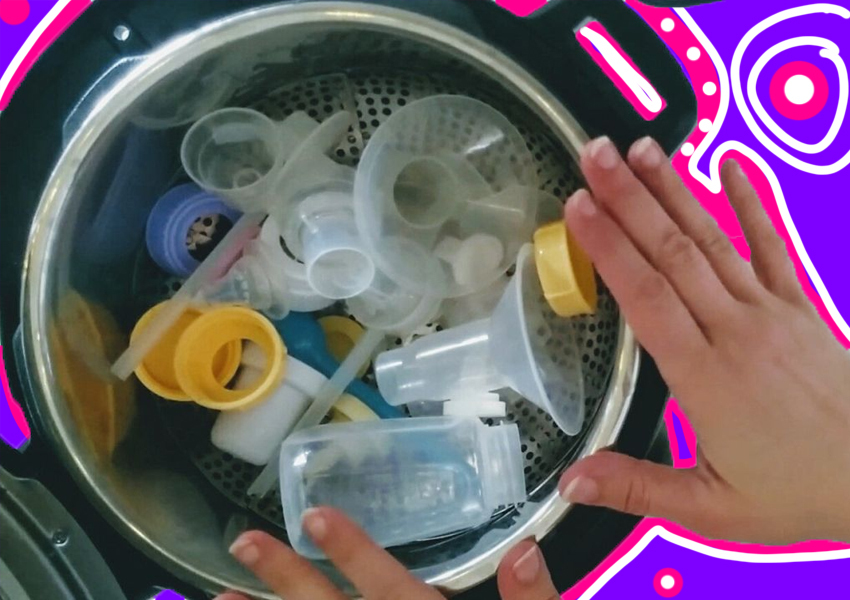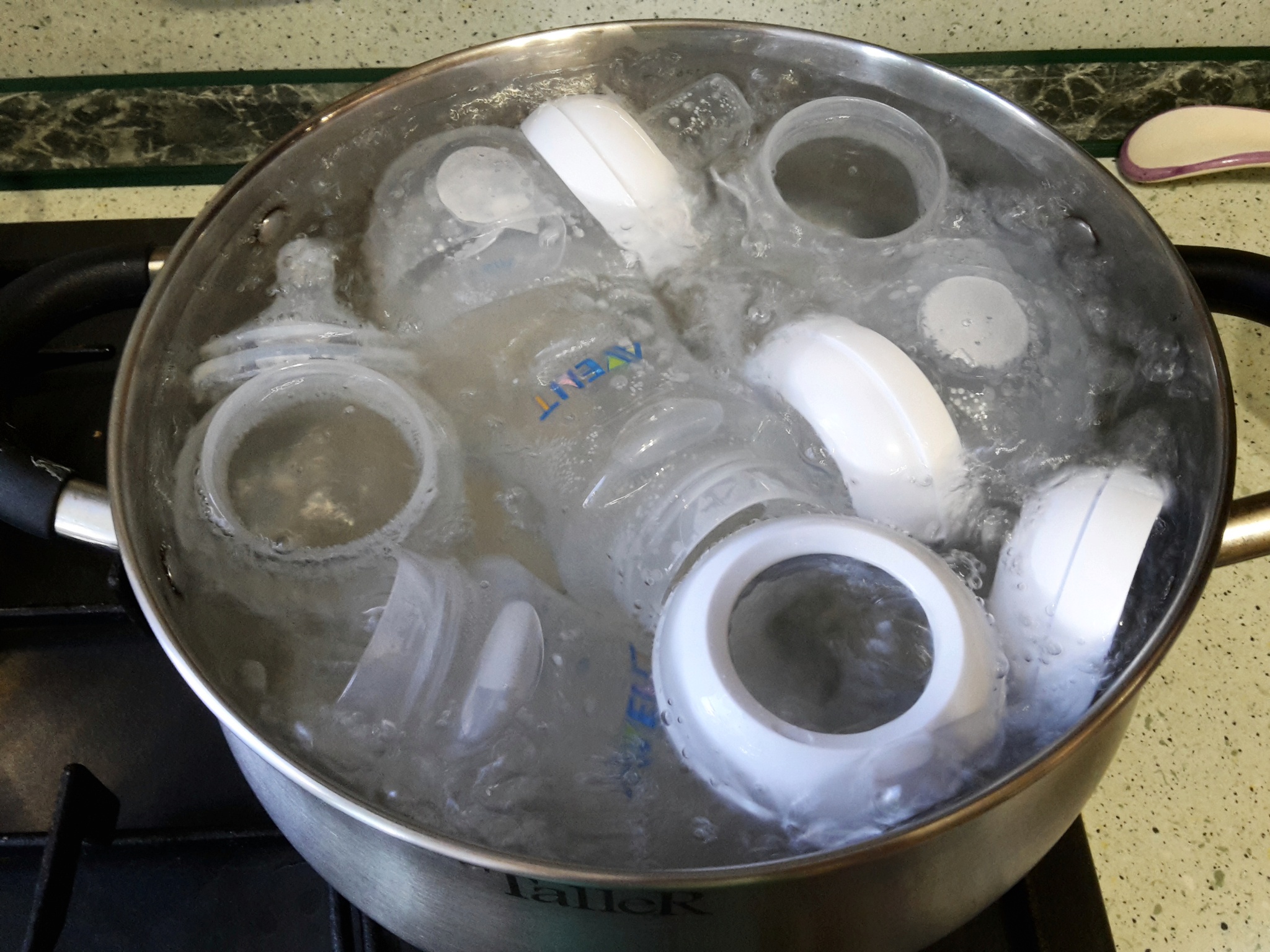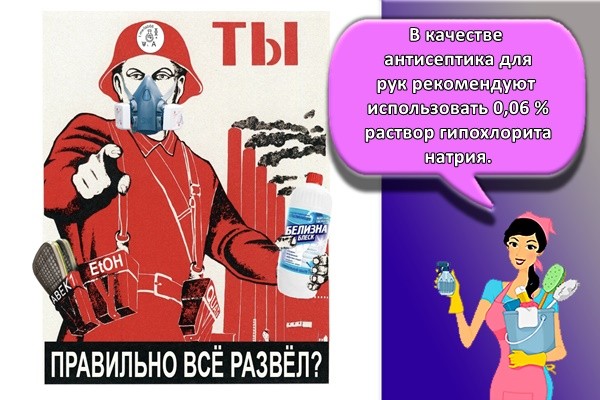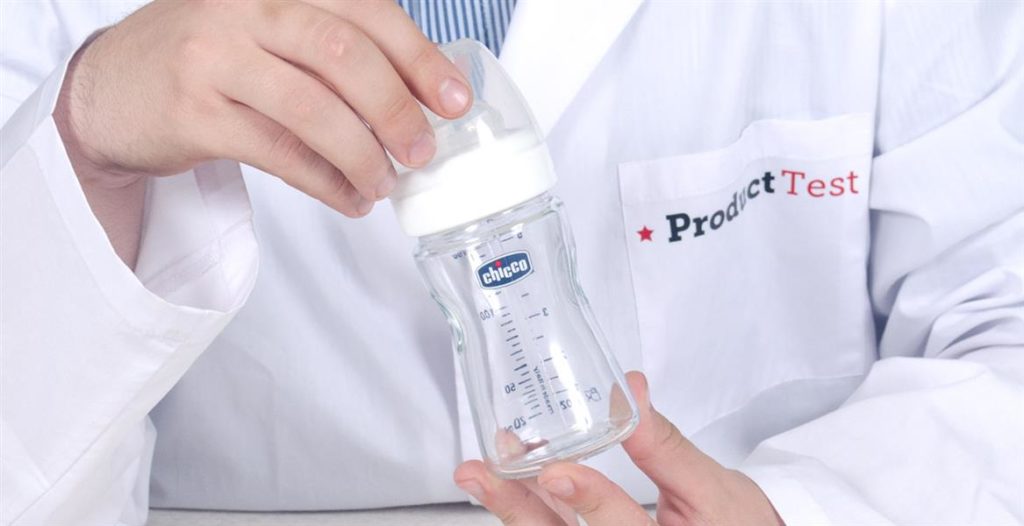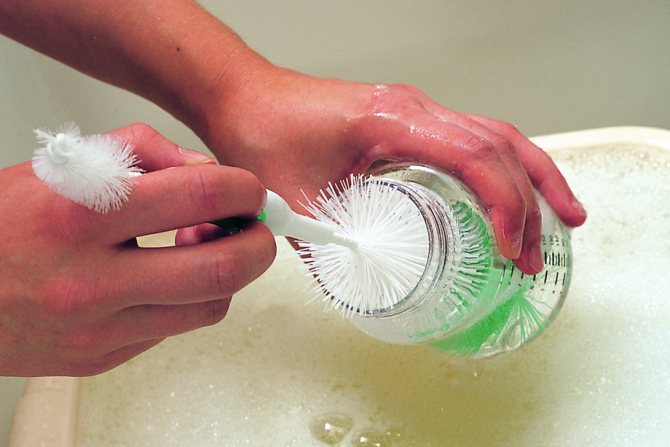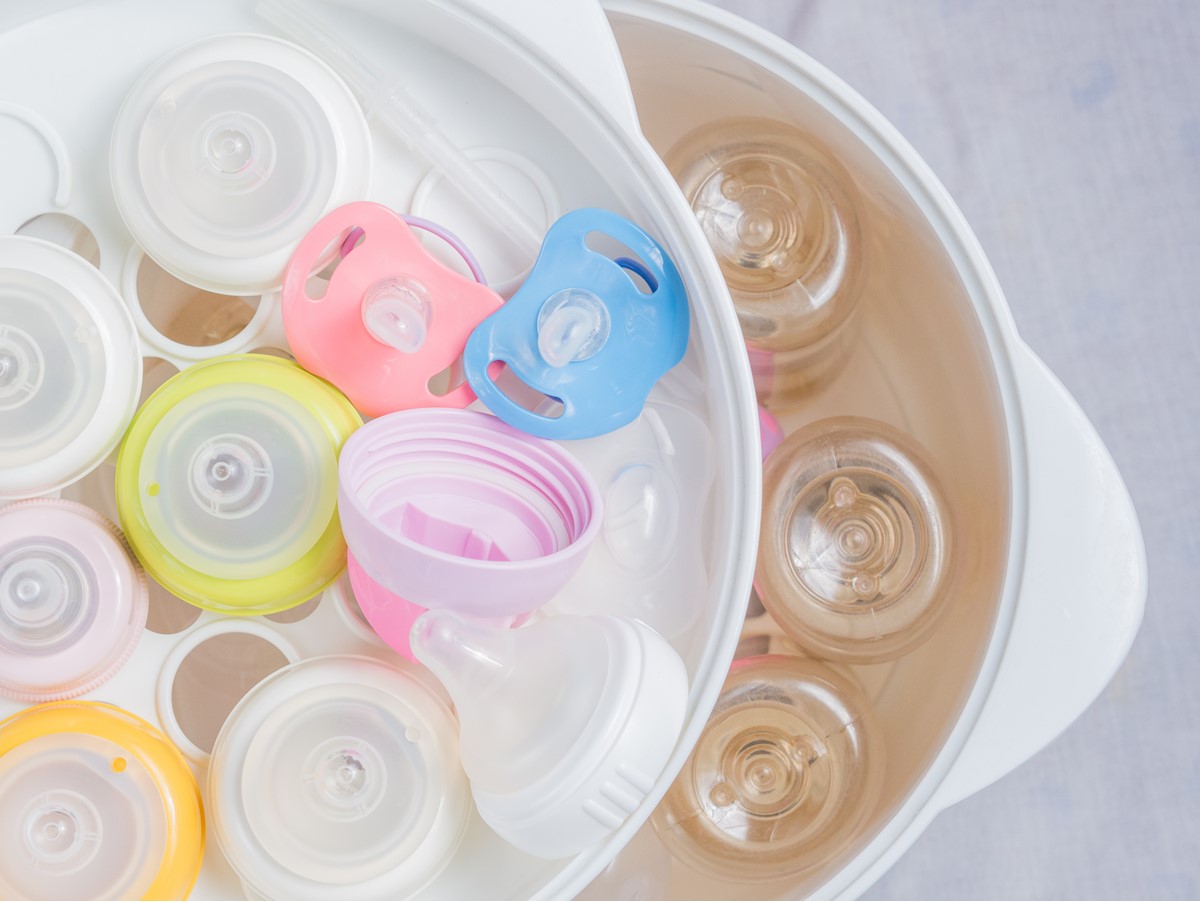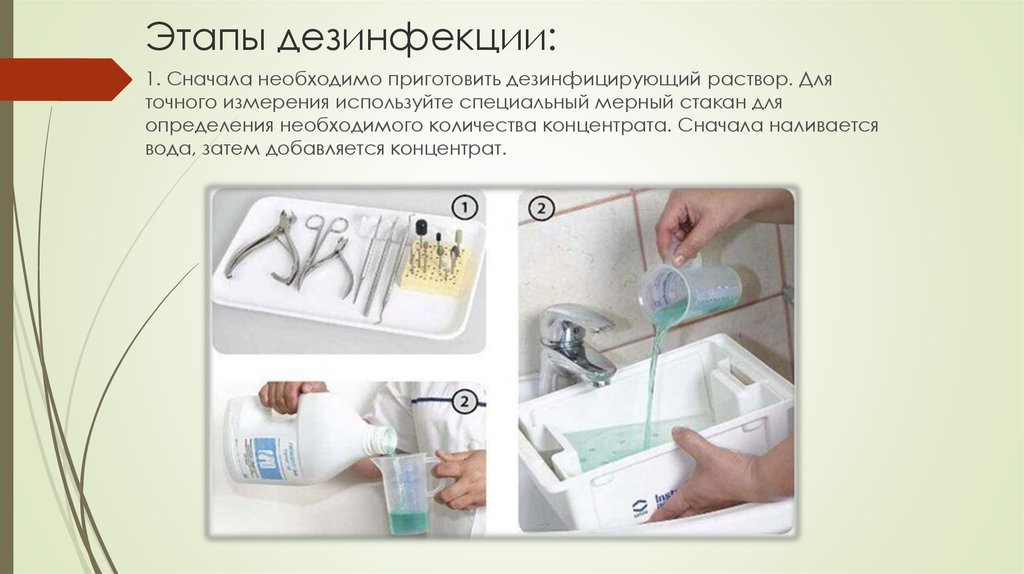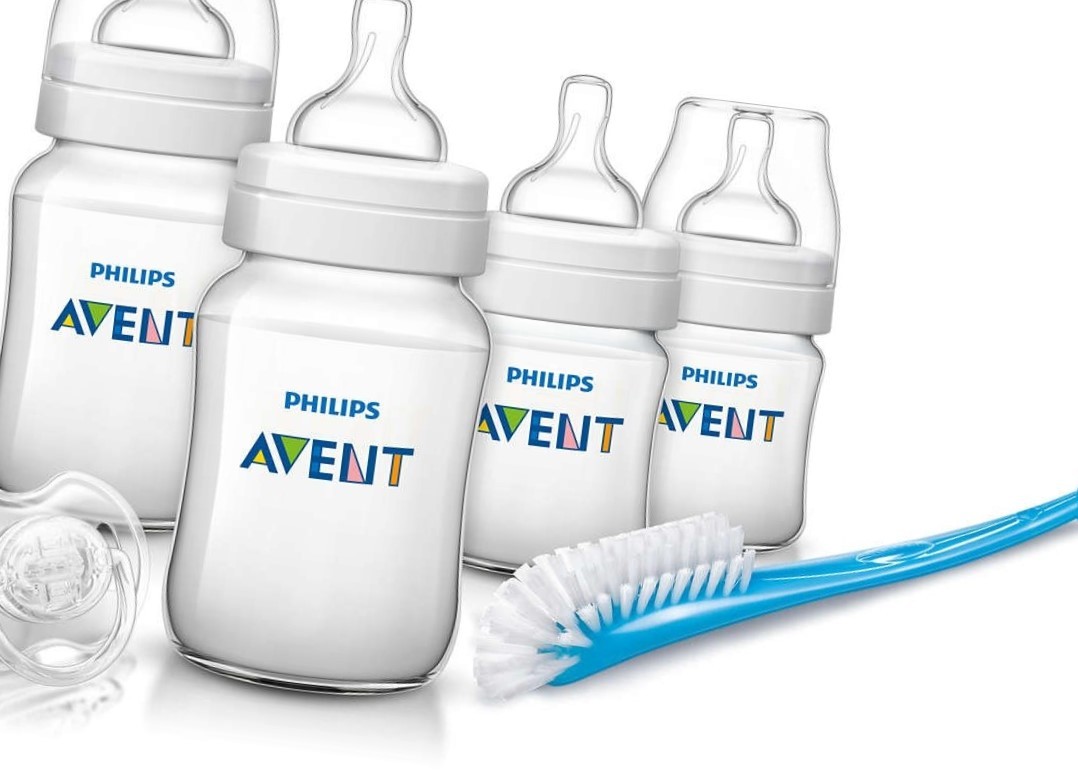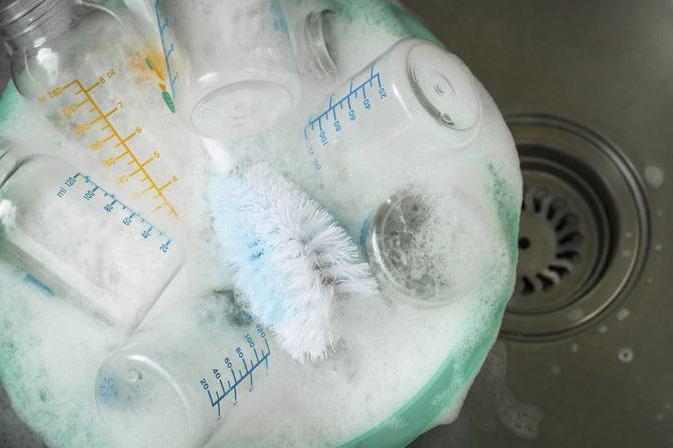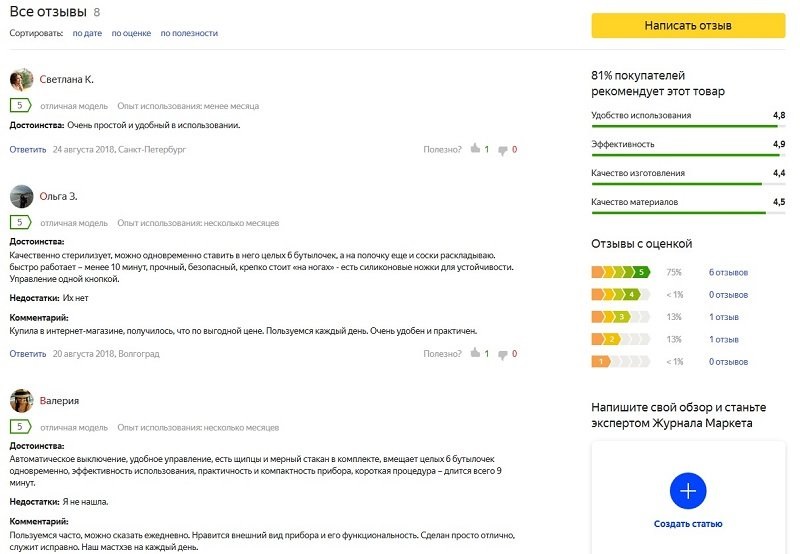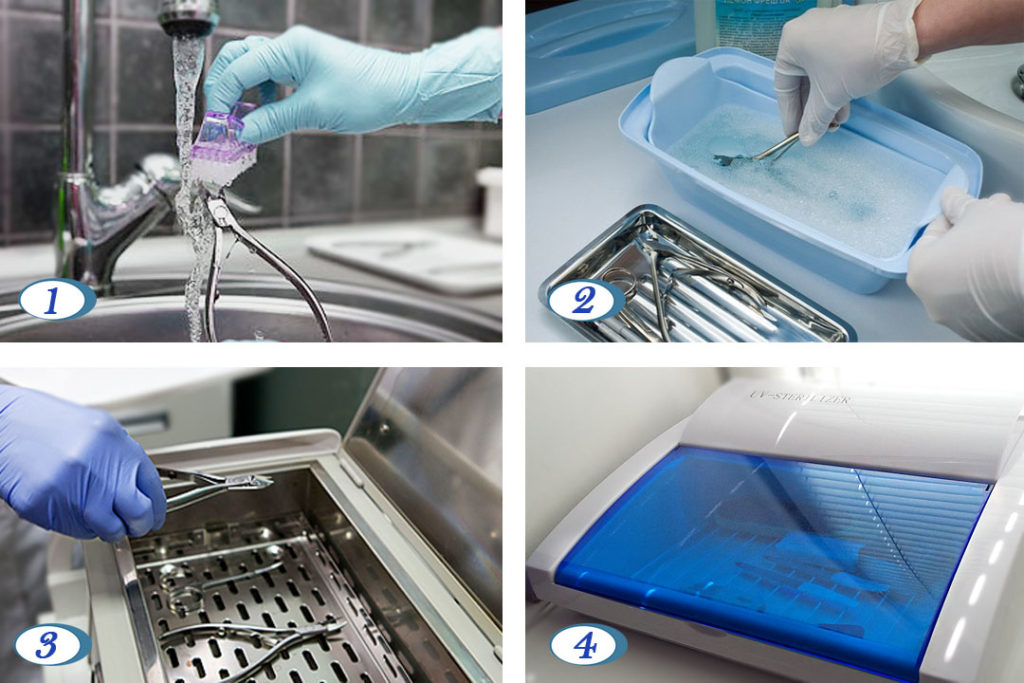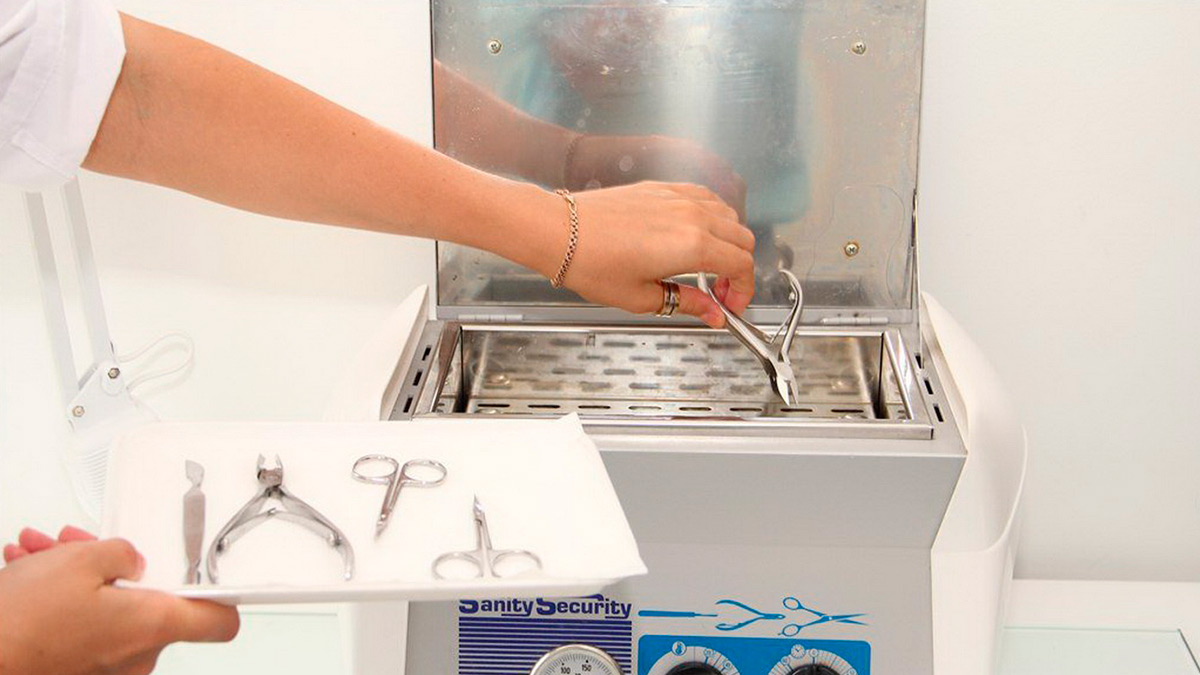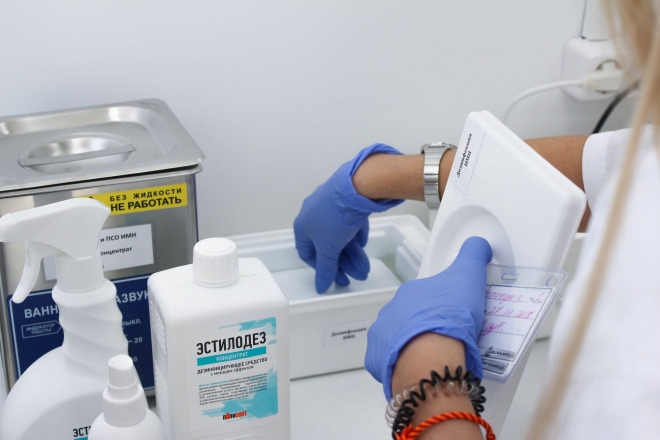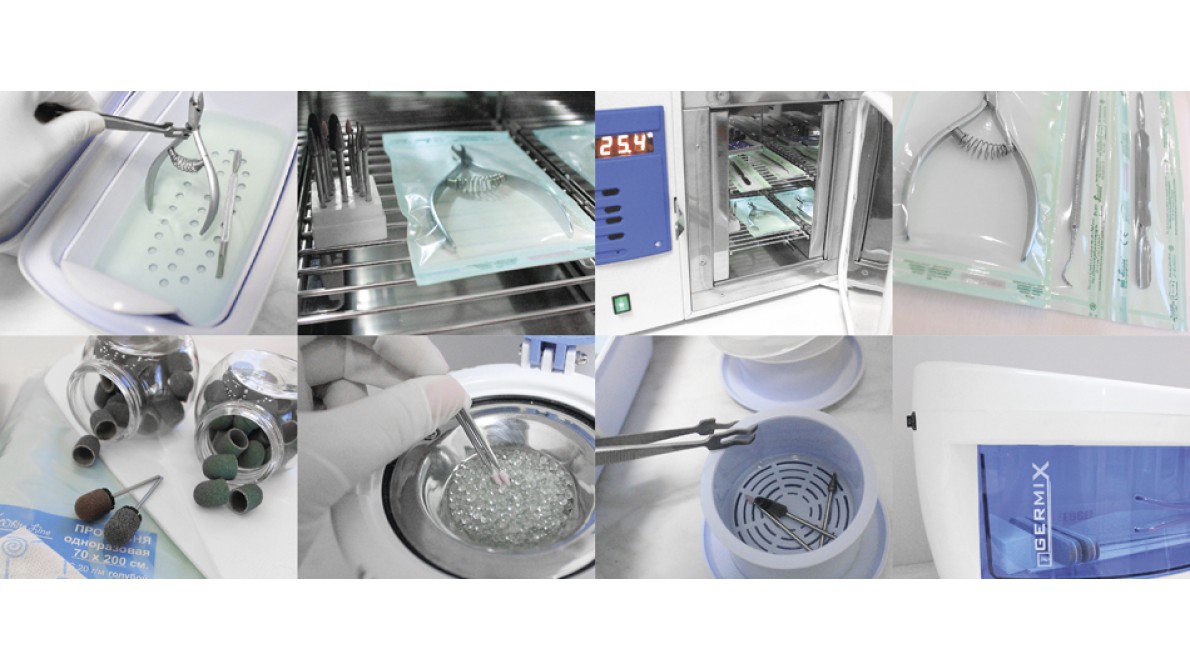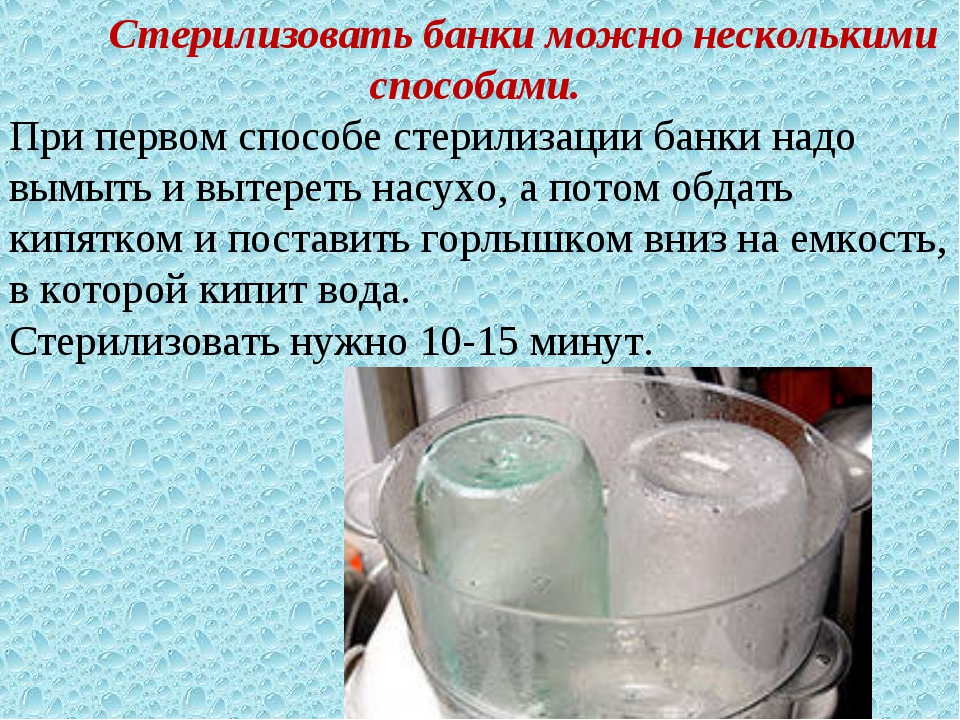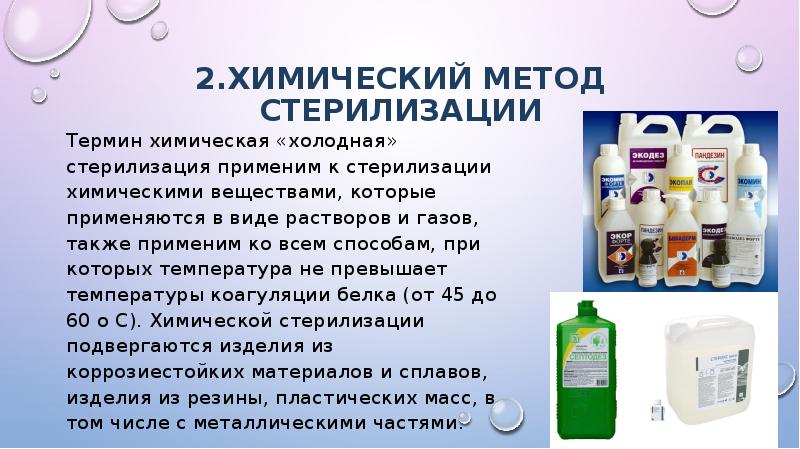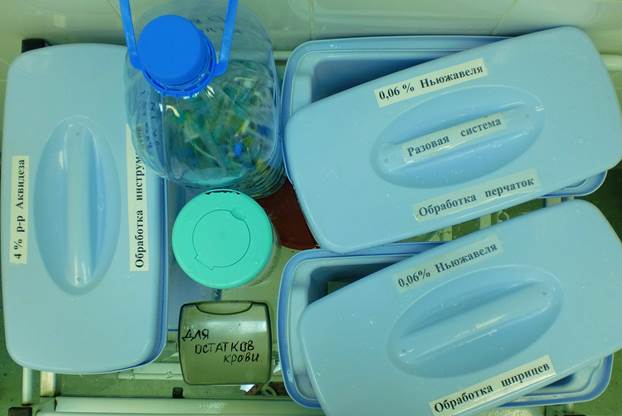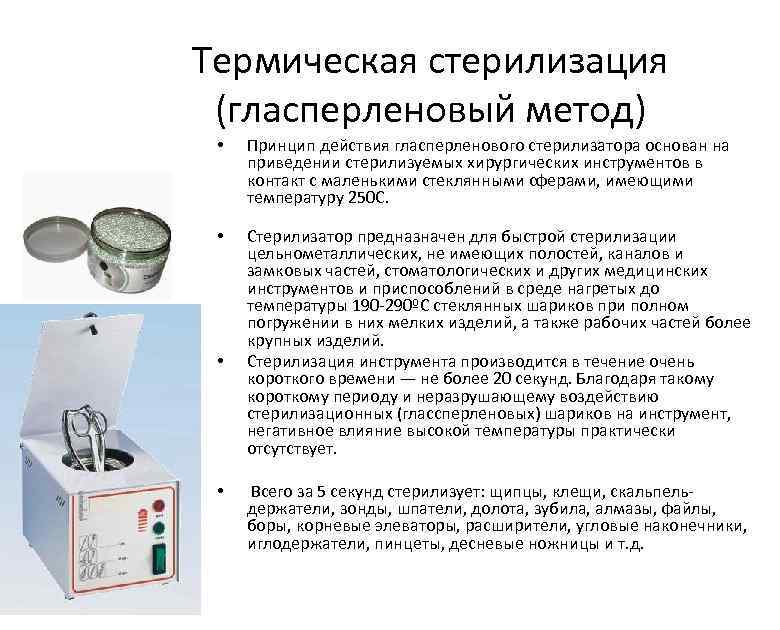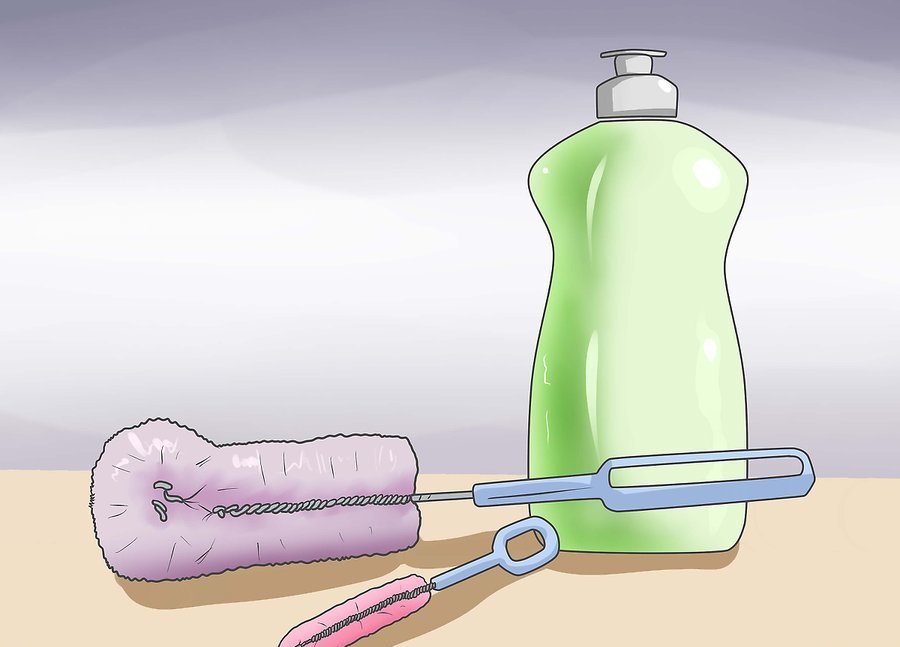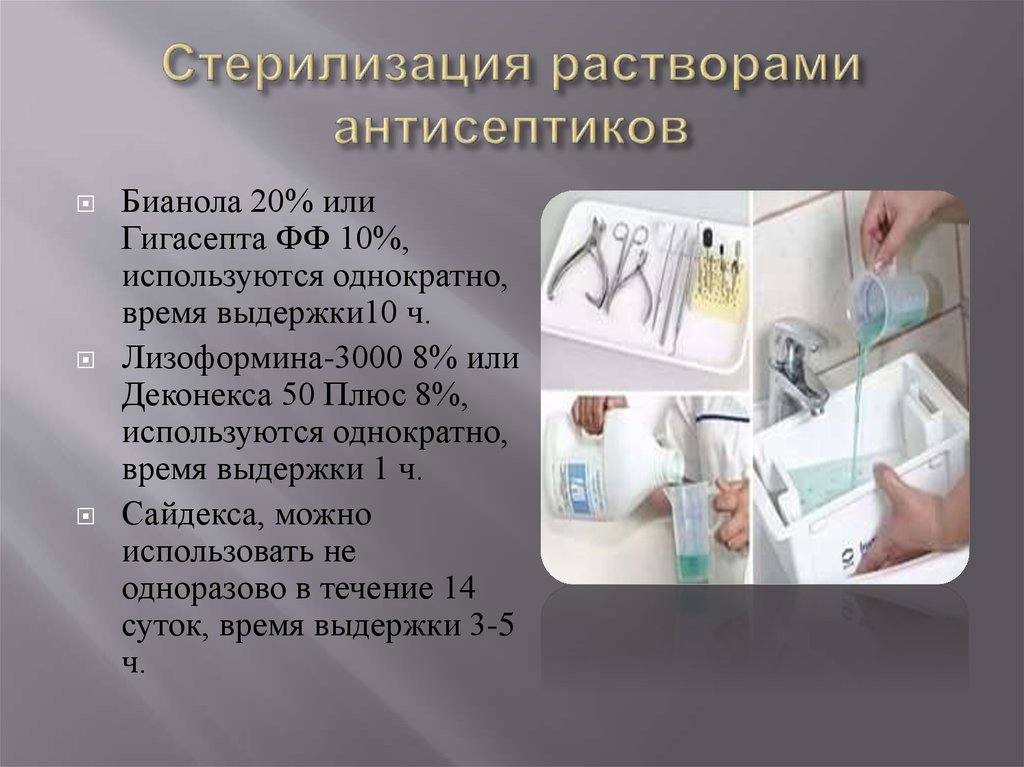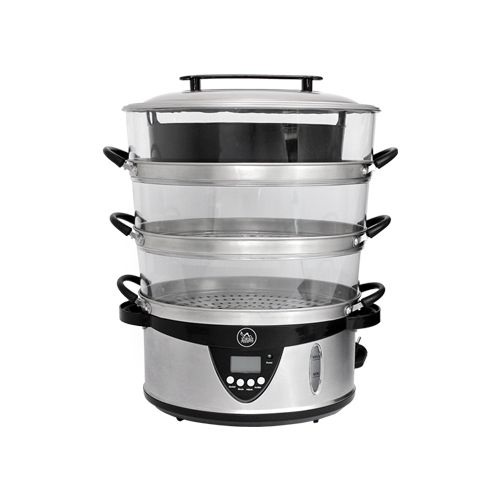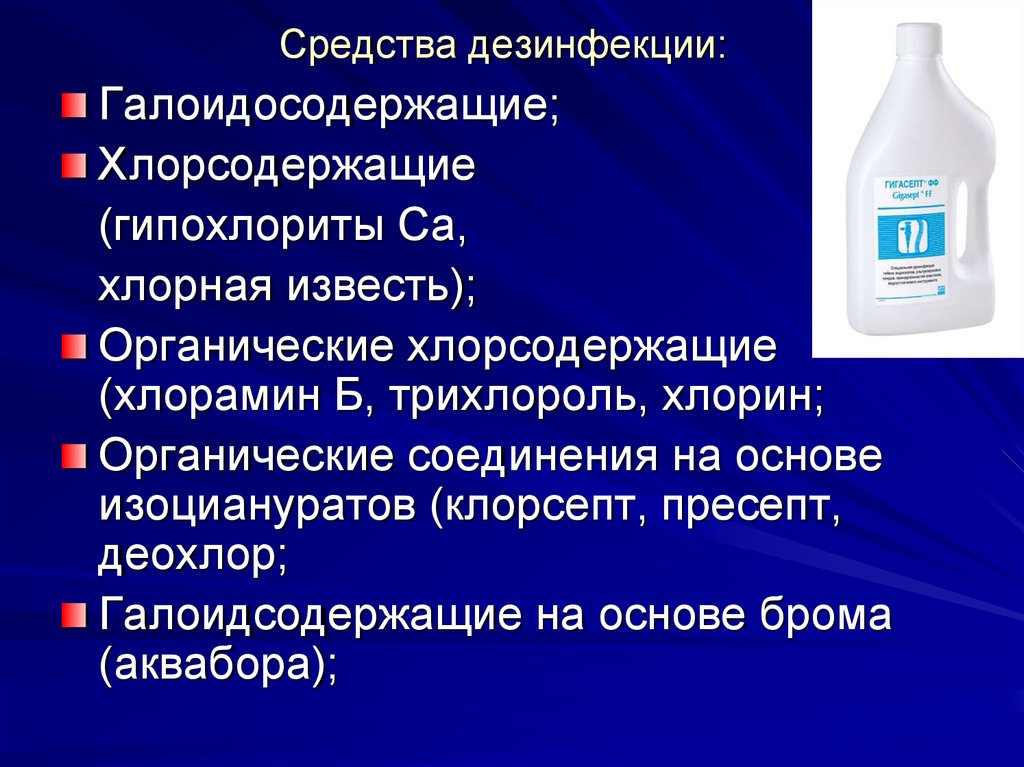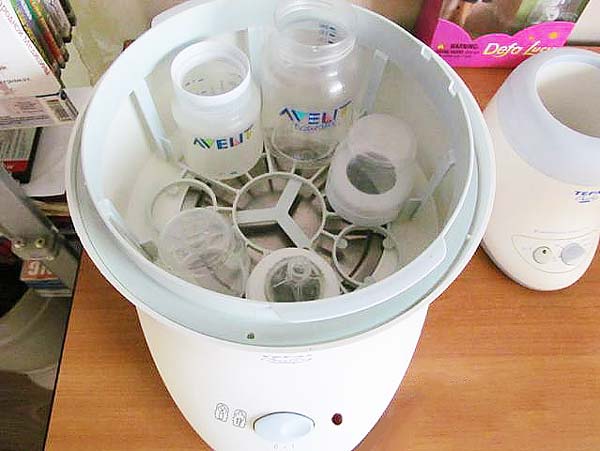How to wash baby bottles when traveling?
The best way to wash baby bottles is in drinking water.
In the absence of such, you can do this under running water, after washing the sink.
Since the quality of the water used is unknown, the dishes must be sterilized after such washing.
If this is not possible, you need to rinse it with the hottest water possible.
When traveling, special aseptic tablets will also come in handy, which can sterilize children's dishes in cold water in half an hour.
For travel lovers, special sterile bottle liners have been created: they are taken out after each feeding, and the container itself remains clean.
Thus, parents should approach the issue of cleanliness of children's dishes with all responsibility. The baby's immature immunity may not be able to cope with the bacteria that have appeared in a poorly washed feeding bottle.
Accessories for sterilizing baby bottles
You can buy a stovetop-heated sterilizer, which is essentially an ordinary saucepan, or an electric sterilizer that turns itself off at a set time. Sterilizers are usually sold in a set with all the coasters, bottles, plugs, nipples and rings you will need the first time, as well as bottle cleaners and forceps. You can also use a fairly large saucepan for these purposes, in which you can put the required number of bottles in a colander (in the first weeks, they usually need from 6 to 8 pieces per day) along with all other accessories.
The forceps are sterilized together with all accessories. With their help, it is more convenient to get hot bottles. Grip the nipples by the edges, not the part that the baby puts in his mouth. When the time is right for feeding, pour the required amount of the formula into a sterilized or disposable bottle, and put the jar back in the refrigerator.
Methods for sterilizing bottles and nipples at home

Boiling disinfection
Bottles made from modern materials deteriorate from frequent boiling. Boiling is best carried by glass bottles. But they are now used less and less.
To boil nipples and bottles, they must be placed in a wide pot of clean water and boiled. Boil time up to 10-15 minutes. Then drain the water, put the dishes upside down on a clean, dry towel. Boiled dishes remain sterile for about 30 minutes.
Steam treatment
If you do not have the necessary household appliances, you can sterilize the dishes using steam over a saucepan. You need to take a colander under the bottles and hold it over a pot of boiling water for about 10 minutes.
You can sterilize baby food accessories in a double boiler. The lower compartment of the steamer must be filled with water. Place all baby dishes in the upper compartment, so that the bottle necks are facing downward. Next, you need to turn on the "cooking" mode and sterilize for 10 - 15 minutes. After steaming, turn off the steamer and let the cookware cool down.
To sterilize children's dishes in a multicooker, they must be folded into a special grid, which is installed in a multicooker. You need to pour about 1 liter of water into the multicooker bowl, set the "steam" mode. Then sterilization takes place for 7-10 minutes. After processing the dishes, they need to be allowed to cool.
Microwave disinfection
The method is distinguished by its simplicity. You will need glass sturdy glassware. Water is poured into the bottom of the dishes, then the dishes are placed. The processing time takes 6-8 minutes at maximum power.
Oven sterilization

You can disinfect nipples and bottles from germs in the oven. They need to be put on a baking sheet with the neck down or put with the neck up, but pour about 50 ml of water into them. Preheat the oven to 180-200 0С and sterilize the dishes for 20-30 minutes.
Processing in industrial sterilizers for baby dishes
The method is simple and safe. Some appliances require electricity to operate, others require batteries, and others require a microwave oven. They can hold a different amount of dishes, depending on the model.
A sterilizer for disinfection in a microwave oven is a container made of special plastic, water is poured into it. Nipples and bottles are placed there with the neck down. The sterilizer is closed and placed in the microwave. The processing time is 5-8 minutes at medium to high power. Disinfection in this case occurs according to the principle of steam treatment.
In addition to plastic containers, you can buy specially designed plastic bags for sterilization. These bags contain children's dishes. Then the bag must be placed in the microwave. Sterilization time from 90 seconds or more at medium or high power (indicated on the package). One such bag can be used 20 times. It is very convenient to take them on a visit, on trips.
Electric sterilizers have proven themselves well. They fit a different number of bottles, depending on the model chosen. The principle of disinfection is hot steam treatment. The processing time will take from 8 to 15 minutes. When the lid is closed, the dishes remain sterile for up to 6 hours.
Another type of sterilizer is the battery operated UV sterilizer. Since no electricity is required, this device is convenient for travel. No water is needed either. You just need to put clean children's dishes into the device. Processing takes about 5 minutes. This method is also good in that there is no risk of getting burned.
Chemical sterilization

This method of disinfecting bottles involves the presence of antiseptic tablets. The method is good for those cases when the bottles cannot be sterilized in another way (for example, on a trip). The antiseptic tablet is dissolved in water, then the dishes are placed in it for half an hour. After finishing processing, the dishes must be rinsed. The properties of the prepared solution are maintained for about a day. This sterilization method is quite costly.
Thus, the choice of a method for disinfecting children's dishes is quite large. Each mother chooses her method depending on her lifestyle, on her financial situation and on the presence of one or another household appliances at home.
Keep in mind that hot water or steam can cause burns, so caution is essential when decontaminating baby feeding equipment.
Natalia Volkova, neonatologist, specially for the Mirmam.pro website
Tips for moms
Sterilize dishes and teats for every feeding! In this case, it is better to sterilize pacifiers and bottles separately. Before the procedure, be sure to wash the container and remove the leftover food with a brush, sponge and safe products. Rinse each item thoroughly.
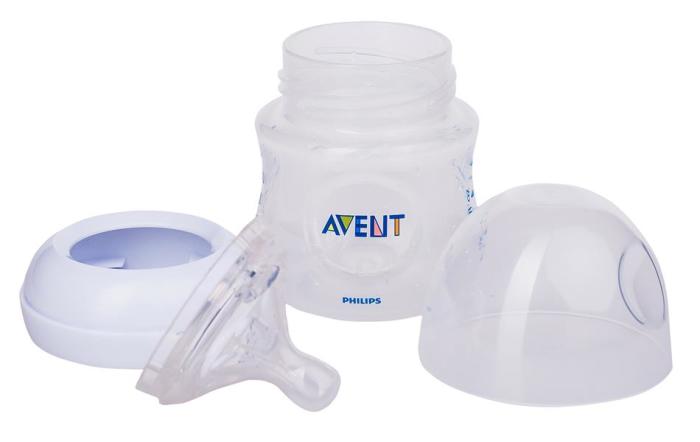
Note that not every bottle can be boiled multiple times. So, plastic products are deformed after several procedures. But many mothers choose plastic, as it is a lightweight, convenient and safe bottle for a newborn. If you have chosen such a material, choose a quality food grade plastic and use the cold sterilization method.
Wash the bottle immediately after feeding or pre-boil several bottles. Remember to prepare the infant formula just before feeding. Thus, sterilized feeding utensils will be at hand!
Cleaning brushes
Plaque settles on the walls of the bottles, food debris accumulates, in which microbes begin to multiply. Not all detergents dissolve deposits; they can be removed with a special sponge or other device.
With foam tip
There are several types of brushes, does not scratch glass or plastic, but copes with dirt and plaque. The product has a foam tip that extends when you press a button.
Dr. Brown
The brush, produced by a well-known company, consists of a sponge and bristles, easily penetrates into the bottle with a narrow neck, cleans the remains of the mixture, removes plaque, and is attached to the surface with a suction cup.
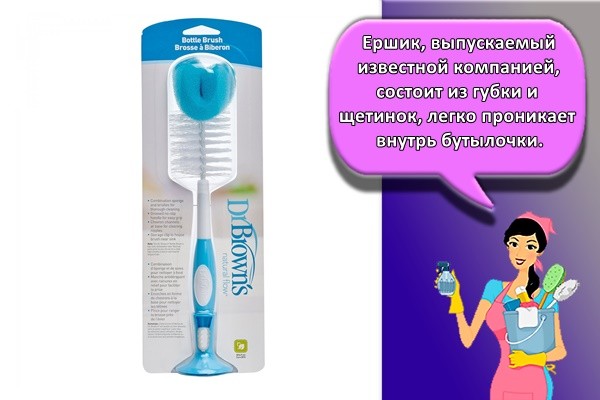
With sponge
It is convenient to wash glass and propylene pacifiers and baby dishes with a brush and a sponge made of natural porous material. When the brush rotates, the bottom of the bottle is well cleaned, milk residues are removed from the protrusions.
2 in 1
The double-sided brush equipped with a sponge is designed for the daily care of baby dishes, nipples, pacifiers. It not only removes food debris, but also kills germs with the help of bristles.
Chicco
The brush of this model performs several functions. Tweezers are built into the handle of the item, which makes it easy to take out the bottles after sterilization.
Sterilization methods
Our mothers boiled baby bottles in a saucepan or held them over the steam with their neck down in a colander. Modern manufacturers of accessories have taken care of our convenience, and many devices have appeared on the market for baby products to facilitate the sterilization process.
Steam sterilizers
Of course, such products are very helpful for young mothers. And they really have a lot of advantages:
large capacity will allow the mother of an artificial artist to wash and then sterilize the bottles in large batches - 6-8 disassembled containers;
the sterility of the containers when the lid of the apparatus is closed is maintained for 3 hours;
long-term steam treatment (about 8-12 minutes) destroys odors, which is important if you give teas and infusions to the baby in the same bottles as the mixture, or do not have time to wash them in time;
since the device turns itself off when sterilization is complete, there is no risk that you will "digest" the bottles, forgetting to worry about handling them.
There are few disadvantages of such products:
- there is a risk of scalding by steam when opening the lid;
- since the device is powered from an outlet, you will need to place it closer to the source of electricity;
- some models are large and can take up a lot of usable space on the countertop.
If you don't want to spend money on an electric sterilizer, you can steam the bottles by placing them upside down in a colander, which is placed in a saucepan of boiling water.
It is important not to forget that children's dishes are sterilized in the kitchen, because when the water boils off, the temperature will rise, and the plastic with latex will begin to melt.
Microwave
You can also sterilize the bottles in the microwave, there are several ways to do this.
Disassembled, washed bottles should be placed in a microwave-safe container with a lid and filled with cold water. Select a mode with 100% power for 7-8 minutes.
There are steam sterilizers for use in microwave ovens.
You can also purchase reusable bottle bags. They are specially designed to sterilize baby dishes in the microwave. Thanks to the special material, you can use one bag about 20 times. Several disassembled bottles are placed in the product, water is poured up to the mark, the bag is hermetically sealed, and after a few minutes the dishes are sterile.
Manufacturers of baby products have created special bottles that can withstand exposure to microwaves without placing the container in an aquatic environment.You only need to wash such a vessel and put it to sterilize inside household appliances for 1.5 minutes
It is only important not to tighten the retaining ring all the way to avoid pressure build-up inside the bottle.
Boiling
Boiling is the easiest and cheapest way to sterilize baby bottles. For this process, you will need to allocate a permanent saucepan that will hold the bottles.
The containers must be washed, and then folded in a disassembled pan, filled with water and boiled for no more than 10 minutes. It is advisable not to leave the kitchen while the bottles are being processed, and make sure that the latex nipples do not touch the hot metal walls to prevent them from deforming and sticking together.
After the baby dishes have boiled, you need to put them on the dryer or on an ironed towel. When the bottles are cool and dry, you can “collect” them and use them.
Antiseptics in tablets
Another method of sterilization is available to modern mothers - with the help of antiseptic tablets. You need to dilute them according to the instructions in cold water and completely immerse the washed bottles, nipples and securing rings in the resulting solution. After half an hour, baby dishes can be used.
You can rinse the bottles with boiled water, but the manufacturers claim that the composition of the solution is safe and does not require rinsing. In an antiseptic liquid, dishes can be stored for no more than a day, after this time, a new solution should be made and the containers in it should be sterilized.
Steamer and dishwasher
Sterilization in a double boiler
The steamer is capable of sterilizing several bottles of standard or enlarged diameter at a time. It is quite simple to use it:
- pour water into the appropriate compartment;
- place bottles on the bottom section, placing them upside down;
- put nipples and pacifiers on the upper section;
- set the sterilization time to 5-15 minutes.
Sterilization in a multicooker
Young parents who have a multicooker in the kitchen can entrust the antiseptic treatment of children's dishes to this device:
- pour 1 liter of water into the washed multicooker bowl;
- put a grate for steam treatment inside the device;
- put washed bottles, lids and nipples on it sideways, and if the internal volume of the device allows, put the bottles with their neck down;
- close the lid of the multicooker and turn on the "sterilization" mode for 5-7 minutes or the "steam cooking" mode for 10-15 minutes.
After the multicooker or steamer finishes its work, it remains to take out sterile items, put them in a clean container, plate or spread out on a towel.
Ideas for storing things: life hacks, tips, do-it-yourself tools
How to sterilize nipples in an electric steamer? This kitchen gadget is most convenient for sterilizing nipples and bottles. The timer, which is equipped with the device, allows you not to waste time monitoring the condition of the nipple.
Can nipples be sterilized in the dishwasher? If the device is equipped with a mode with a temperature above 80 degrees, then the machine can also be used to help mothers. Otherwise, the nipples will simply be washed out, but sterilization will not occur.
To sterilize a baby bottle in a double boiler, remove the bottom of one bowl. So that the bottles fit upside down in it. Cover the steamer with a lid and turn it on for 5-7 minutes.
5 Antiseptic tablets
At home, you can use special antiseptic tablets or powders, such as JEX. Their use will not cause any special problems:
- pour cold water into a container of a suitable size (bowl, saucepan);
- dissolve a disinfectant in water;
- place baby dishes, nipples, pacifiers in the solution;
- cover the container with a lid and stand for half an hour;
- after 30 minutes, remove all items and rinse with clean boiled water.
For all its seeming simplicity, this method of sterilization is not very popular with modern parents: some are afraid to use chemicals, others do not want to spend money on buying pills and powders. Such disinfection also has supporters: boiling water is not needed during processing, and the ready-made antiseptic solution retains its properties for 24 hours. The tablets are convenient to use outside the home when other methods of sterilization are not available, for example, while traveling.
Pediatricians' opinions on sterilization
Some of the pediatric doctors do not support procedures to ensure the sterility of children's dishes. Many pediatricians do not believe that newborn bottles need to be sterilized.
They are sure that such antiseptic conditions lead to the development of allergies in the child, and also provoke the body to an acute reaction to viruses and bacteria, which are much more difficult than in ordinary children.
At the same time, pediatricians are sure that this is not a reason for a complete lack of hygiene, since ordinary cleanliness is the key to the health of children and adults. However, it is necessary to sterilize containers containing formula or breast milk.
The remains of the mixture that the child has not eaten are not subject to further storage. They must be discarded, and the bottle must be washed and sterilized.
The process of processing baby dishes is very necessary for a newborn, especially in the first months after birth. Mom can use the sterilization methods that are most convenient for her.
To sterilize or not: opinions of pediatricians
Children's doctors still do not come to a consensus on whether it is really necessary to sterilize baby food bottles or just wash them thoroughly and rinse them with boiling water.
 Doctors still have not come to a consensus on whether it is necessary to sterilize the bottles.
Doctors still have not come to a consensus on whether it is necessary to sterilize the bottles.
European pediatricians do not advise new mothers to do this, as they believe that sterilization of dishes harms the child's immune system. Doctors from Europe believe that the child's body must get used to various bacteria from the first days in order to develop antibodies to destroy them.
Komarovsky's opinion
Doctor Evgeny Komarovsky fully supports the opinion of his Western colleagues.
The authoritative pediatrician Yevgeny Komarovsky fully supports the opinion of his Western colleagues. According to him, viruses, bacteria and harmful microorganisms surround a person everywhere and it is impossible to defend against their effects. And by sterilizing and disinfecting dishes and objects surrounding the child, mothers only harm the baby, because his immunity will not get stronger properly and in the future the child will not be able to resist microbes and viruses.
Rules for taking into account when feeding
Regardless of whether breast milk was in a bottle or in a diluted formula, it is not recommended to store it there for more than an hour. The remains of milk after feeding should always be poured out, because microorganisms managed to get into it from the oral cavity during feeding. If for some reason the mother cannot or does not want to dilute the mixture every time, then it is allowed to dilute several portions of the milk mixture at a time. But they must be bred in different bottles and stored strictly in the refrigerator, and heated before feeding.
If the bottle is not used for a long time, then its storage is permissible in the assembled and closed form with a cap. This will help to avoid the population of its unnecessary bacteria.
How to sterilize baby bottles at home in the microwave
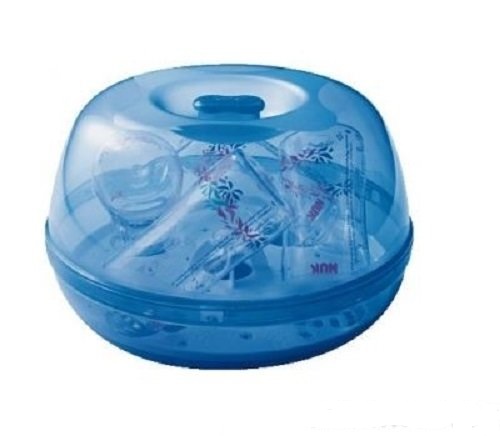
Modern moms and dads adapt so quickly to everything that they easily endow household appliances with new functions. And manufacturers, in turn, keep up with them and produce special sterilizers and bags for microwave ovens and steamers with a sterilization function. So you can sterilize baby bottles at home in the microwave as well.
Using any container
Pour 2 cm of water into a clean microwave bowl and put the bottles disassembled, close the bowl. Turn on the timer for 2 minutes. Then leave it covered for 5 minutes.
Bottle sterilization bags
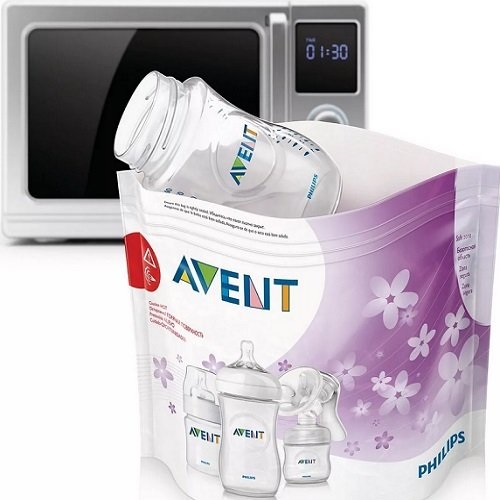
Pour the specified amount of water into the bag, fasten it, put it in the microwave for the required time. Be careful, you can get burned when opening the package! Let it cool down a bit.
Microwave Sterilizer
For parents who often sterilize bottles, but the budget does not allow buying a full-fledged sterilizer, a microwave sterilizer is suitable. It is a container with a closable lid and special compartments for bottles and nipples. In such a sterilizer, you can sterilize several bottles at one time and take them out as needed. Each such device is equipped with detailed operating instructions.
Sterilization errors
When performing sterilization, it is necessary to follow a number of rules that will help make the process effective:
- Mom is obliged to follow the rules of hygiene. Before using sterile bottles, she should thoroughly wash her hands with soap and water;
- In order to sterilize children's accessories, you need to have separate utensils, and not the one that is used to prepare food for all family members;
- Do not be afraid to use detergents if the residues on the bottle are oily and difficult to remove;
Important! The risk of dishwashing liquid poisoning is incomparably lower (and even impossible with thorough rinsing) than the risk of food poisoning
- Think carefully before purchasing a bottle. Bottles with unusual shapes, such as a hole in the middle, are suitable for drinking water, not milk. They are very difficult to rinse out;

Bottles of unusual shape
- If you put breast pumps in a multicooker or microwave without adding water, they can deform.
Breeding formula for newborns
Preparing baby food is an important process. You need to know how to make a formula for a newborn so that your baby gets healthy and tasty food every day that will help him grow and develop.
Correct dilution of milk formula
To feed your baby with quality food, you need to buy a good mixture that is suitable for his age and other indications. For example, “Similak Premium”, “Nan”, “Nestogen” and other brands received good marks from doctors and parents for the smallest.
Before mixing infant formula, you must purchase bottled water intended for babies. It contains a minimum amount of trace elements that can overload the kidneys of a child; such water does not need to be boiled. In the absence of bottled water, you can use filtered tap water, but it must be boiled beforehand.

Breeding milk mixture
Infant formula is valuable and healthy for an infant when prepared in strict accordance with the instructions provided. They tell you how to properly dilute infant formula and other information you need to know.
What you should pay attention to:
- The proportions of powder and water are most important for the child. The box with the product always indicates how many measuring spoons of powder you need to dilute in a certain amount of water, the age of the baby, as well as the number of servings per day;
Important! Cooking a mixture that is too thick or too watery can harm your baby. With an increased amount of trace elements and protein in one serving, the digestive system of the crumbs may not be able to cope
If the powder is diluted with plenty of water, the baby will not get enough food.
If the manufacturer indicates that the mixture is suitable for consumption within 4 weeks after opening the package, then after this period it must be thrown away;
The child grows, so the amount of food is gradually increasing. If at the age of 6 months he needs to make 180 ml of the mixture, then after 2 months he will drink 210 ml. When diluting more food, the proportions of water and mixture are preserved;
Breeding technique. You need to dilute the powder by adding it to a bottle of filled water, and not vice versa, adding liquid to the powder
Then gently shake the bottle until the mixture is completely dissolved.
In this case, vigorous shaking will lead to frothing of the milk;
It is important to read the information about the temperature of the water used. In too cold, the powder will not dissolve, it forms lumps.
Mix temperature
For a meal to be effective and comfortable, you need to know what temperature the formula should be for feeding a newborn.
Important! Mixing the powder with boiling water destroys the valuable vitamins and nutrients in the mixture. In order for the formula of the product to retain its properties, it is not allowed to cook it at a high temperature.
The best temperature for feeding a newborn is 36-38 ° C. The product is usually cooked at a temperature of about 40 ° C. It is preferable not to feed the newborn in advance, but to cook right before use. It is also forbidden to leave uneaten milk at a later date - dangerous pathogenic microorganisms can form in food that has come into contact with the child's saliva.
Algorithm for feeding a baby from a bottle:
- In a clean bottle, dilute the required amount of the mixture. Sometimes it is necessary to pour breast milk, which must first be expressed;
- Install the teat and make sure that the milk does not come out in too frequent drops;
- Measure the temperature of milk by applying a couple of drops to the skin of your wrist;
- Give the bottle to the child in the arms. In this case, it should be kept at approximately an angle of 45 °;

Bottle feeding your baby
- When the baby has finished eating, raise him upright and maintain in this position for about 5 minutes. This will allow air to escape if the child spits up, food does not enter the respiratory system.
It is helpful for the child to come into contact with the outside world and bacteria. So his body will learn to make antibodies. Sterile bottles and nipples do not weaken the newborn's immune system, but only protect his digestive system from E. coli and other microbes. While the baby is small and weak, it is best not to take risks and regularly sterilize baby feeding equipment and pacifiers.
How to sterilize baby bottles at home in the microwave
The microwave can only be used to sterilize glass drinking and feeding bottles.
The dishes should be placed in the oven, pour water to a third of the volume. Then you need to set the maximum power. Sterilization time is 2 minutes. Drain the water and let the bottle cool to avoid cracking the glass.
Modern moms and dads adapt so quickly to everything that they easily endow household appliances with new functions. And manufacturers, in turn, keep up with them and produce special sterilizers and bags for microwave ovens and steamers with a sterilization function. So you can sterilize baby bottles at home in the microwave as well.
Pour 2 cm of water into a clean microwave bowl and put the bottles disassembled, close the bowl. Turn on the timer for 2 minutes. Then leave it covered for 5 minutes.
Pour the specified amount of water into the bag, fasten it, put it in the microwave for the required time. Be careful, you can get burned when opening the package! Let it cool down a bit.
For parents who often sterilize bottles, but the budget does not allow buying a full-fledged sterilizer, a microwave sterilizer is suitable.It is a container with a closable lid and special compartments for bottles and nipples. In such a sterilizer, you can sterilize several bottles at one time and take them out as needed. Each such device is equipped with detailed operating instructions.
Necessary preparatory stage
It has been proven that breast milk does not require additional processing. It contains only the elements necessary for the development of the baby. Careful sterilization of bottles is necessary if the baby has been artificially fed for a long time. Together with the mother's milk, the child receives the constituent parts of the immune system - immunoglobulins. Babies deprived of them require increased attention from their parents.
Regardless of the method of sterilization, the container should be thoroughly washed. The container must not contain any traces of milk or plaque. If you cannot get rid of them as a result of water procedures, then the container must be thrown away. Otherwise, it can provoke the development of intestinal infections. It is strictly forbidden to use tap water for water procedures. Baking soda and boiled water are preferred.
In recent years, special detergents have appeared on store shelves that cleanse baby bottles from food debris. These products do not contain hazardous substances. During the initial treatment, you will need a soft brush or brush. It is not recommended to use a dishwasher, as powder residues can get into the container.
It will be useful to find out to what age the bottles should be sterilized before feeding. Most pediatricians are inclined to the point of view that the optimal age is six months. At the same time, doctors emphasize that this figure is not the ultimate truth. It all depends on the immunity of the baby and the conditions of his life.
If the baby was bottle-fed, then the feeding bottles are processed until 18 months of age. Otherwise, the child's undeveloped immune system simply cannot withstand the onslaught of the pathogenic flora.
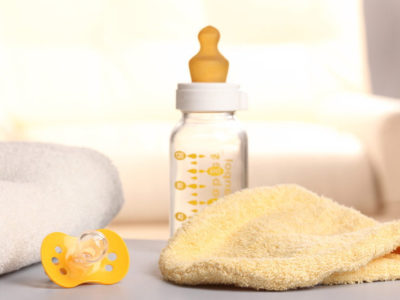
Do I need to sterilize the bottles
Pediatricians insist on the correct conduct of this process. After all, milk formulas are a breeding ground for the development and reproduction of microbes and Escherichia coli. They contain a large amount of sugars, lactose, yeast and lactobacilli. If you leave the milk mixture on the table, then it will mold faster than all other products and begin to emit an unpleasant odor.
In the last century, there was virtually no need to sterilize baby bottles, due to the fact that almost every woman breastfed her baby up to 1 year and older. Modern life, accompanied by stress and negative environmental influences, leads to the fact that many babies need artificial feeding. A woman's breast milk is not enough or is completely absent. This negatively affects the body of the newborn.
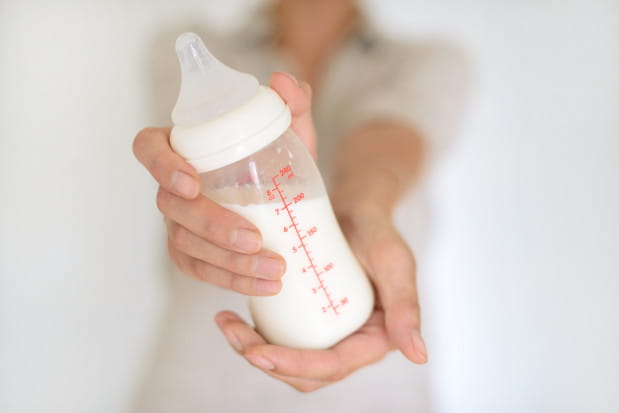
But with breast milk, he receives a lot of vitamins and essential enzymes that strengthen the baby's immune system. At the same time, the child's body can fight a certain amount of bacteria.
E. coli can cause disruption of the digestive tract and its effects are manifested in the form of diarrhea, vomiting, weight loss and dehydration.
To avoid this, moms should sterilize newborn bottles, nipples, and teething rings.
Among foreign pediatricians there are many opponents of disinfection of children's dishes and supporters of the theory of the development of protective functions of the body through its interaction with pathogenic microflora. Among them is the famous pediatrician Komarovsky. He is sure that it is enough to rinse the children's dishes with detergent and then rinse them with water.Sterilization, boiling and other methods lead to the development of allergic reactions in children who grew up in a microbial-free environment.
On the other hand, a baby starting to crawl pulls into his mouth all objects that come across him on the floor. Therefore, there are enough microbes for the development of the immune system.
Sterilized bottles, nipples and other utensils protect the baby's weak body from the influence of E. coli and other microbes.
How long to sterilize bottles
In accordance with international experience, pediatricians recommend sterilizing bottles, pacifiers and other items that a baby can put in his mouth until the age of 4 months. It is impossible to keep the child isolated from the external environment any longer. To strengthen his immune system, he must come into contact with bacteria.
In the case of breastfeeding, the bottle that will be filled with water should be sterilized once a week. With artificial or mixed feeding, the bottles for the mixture are sterilized every 2-3 days.
After 4 months, sterilization can be continued every 2 weeks, on other days it is enough to rinse the bottles with hot water and soap. When the baby is 6 months old, the sterilization can be stopped.
Much depends on the baby. If he is very sensitive, he has a tendency to frequent inflammation of the mouth or diarrhea, you will need to continue sterilizing the bottles.
Important! Sterilization is needed even when the baby is already one year old, if the baby is transported to other climatic conditions (especially warmer ones)
How long does it take to sterilize baby bottles?
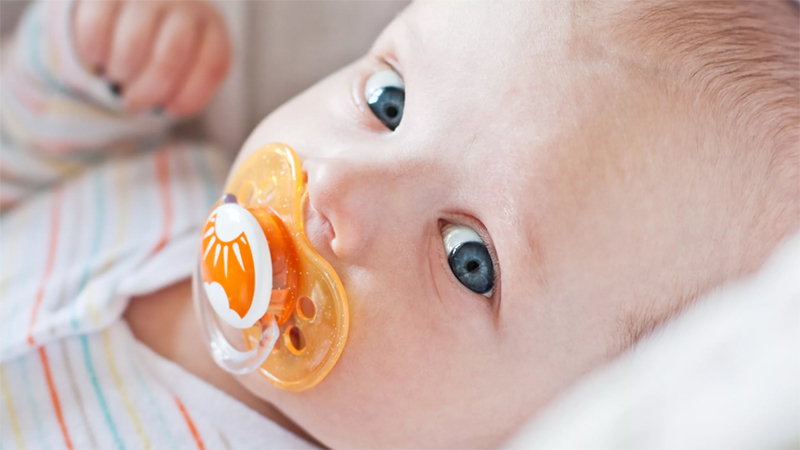 Sterilization is required only until the immune system is able to resist microbes itself. Typically, baby bottles are sterilized up to 12 months of age. After a year, the body's defenses are able to fight viruses and microbes themselves, and they do not need additional protection.
Sterilization is required only until the immune system is able to resist microbes itself. Typically, baby bottles are sterilized up to 12 months of age. After a year, the body's defenses are able to fight viruses and microbes themselves, and they do not need additional protection.
Among pediatricians, you can find common opinions, some believe that sterilization of baby dishes is necessary up to 18 months, while others believe that it can be stopped by 6 months. Parents should take into account that the further the neonatal period goes, the less often it is possible to perform sterilization, and by the age of 1-1.5 years it is completely stopped.
There is also an opinion that sterilization is necessary only in extreme cases, for example:
- before using the bottle for the first time (after purchasing it);
- after a childhood illness;
- after prolonged use.
According to Dr. Komarovsky, sterilization of baby bottles subsequently leads to the development of allergies and weak immunity in the child. He urges parents to sterilize only the dishes in which the milk mixture will subsequently be stored.
Therefore, the only correct decision on how often to sterilize baby bottles is no. Each parent himself chooses the best solution for him.

